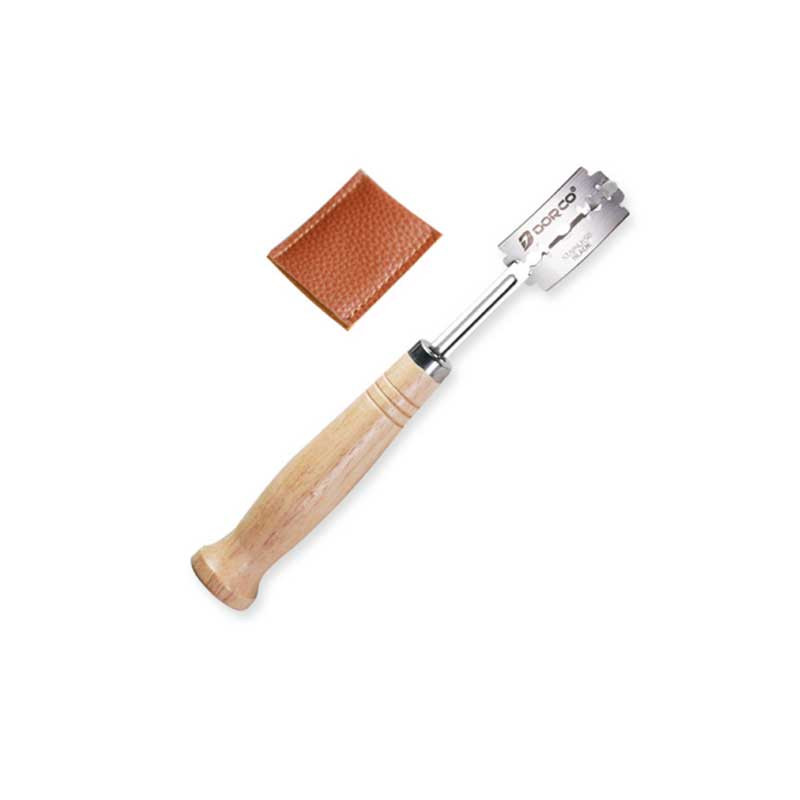





Caution sharp! Keep out of reach of children.
Cut your dough quickly and precisely with this baker's knife or lame de boulanger. During baking, the cut is further torn and a beautiful pattern is created as well as a crispy and fine chipped crust. To be able to cut the dough optimally, the baker's knives must be very sharp, with the leather protection this can be stored safely.
Data sheet
Bread fresh from the bakery is good, a self-kneaded and baked in your own oven is better. Whether you have been passionate about baking bread for a long time or are just starting out, the right equipment is very important for bread. In addition to high-quality flour, an evenly baking and powerful oven, the right baker's knife is also essential. The blades of a professional dough knife are ground extra sharp to ensure precise and deep cuts without the dough warping or sticking to it. To guarantee this, the blade is very easy to replace, five blades are supplied right with the knife.
The baker's knife arrives with five blades. To use them you can thread them through the slots in the middle. For a single curved blade, use the lowest as well as the top notch, for a wavy blade, the hole in the middle is also used. If the blade is not being used at the moment, the leather guard should be put on to prevent injury.
The appropriate cutting technique varies greatly from bread dough to bread dough. How a bread should be cut is determined by many different factors such as the amount of liquid and flour, the intensity and timing of kneading, the baking process, and of course the desired appearance. Always pay attention to the remarks in the instructions, most bread recipes indicate which cut corresponds to the bread.
For a simple diamond pattern, a cross or the typical diagonal incisions, you can use both serrated and smooth bread knives. Shape the bread dough and let it rise again a little covered with a dough plastic or a dough cloth. Depending on the type of bread and the desired pattern, flour the dough well. This is typical with diamond patterns and also looks great with crosses, simple diagonal cuts look great without a floured crust. A sieve should be used for flouring, otherwise unsightly flour spots will appear, and in other places the bread will shimmer through. Then take a baker's knife to hand and keep it nice and straight. Now you can cut your bread in the desired pattern. If the dough is a bit soft and gets warped easily, you can hold it in shape a bit with your other hand. Make sure to make deep enough cuts so that they can tear open nicely afterwards.
Curved blades are particularly suitable for a baguette. This is because the typical slanted cuts are applied much flatter than the cuts mentioned above. Therefore, hold the knife slightly tilted to the side over the fully proofed dough pieces. Now cut in diagonals as parallel as possible, and the skin of the dough should be cut superficially. In contrast to the above technique, the cuts here will not dough already slightly apart. The cut flaps of dough will lay flat again on the baguette and cover the cut a bit. Only during baking do they tear open nicely and thus remain relatively smooth.
Of course, special swirl or floral patterns are particularly beautiful. These you can either cut a little wild and jumbled or very evenly and orderly. First, flour the bread and spread the flour by hand on the dough piece. For a perfect flower, first take a thread to hand, with which you visually first quarter and then eighth the bread on the flour. Now, at each stroke, place the knife in the middle where the lines meet. Then you pull the knife outward in a slight arc, ready is the cut back on the line. This step is repeated on the other side of the line. Proceed in this way for every other line. Now you should see a four-petaled flower. Then place the knife in half of a petal and draw it outward in an arc onto a line that has not yet been used. Again, repeat this on both sides of every other line. This will create a great eight-petaled flower.
So you create breads with beautiful and crispy crust. To keep the blade sharp for as long as possible, do not put it in the dishwasher. Therefore, rinse it only under running water.

Caution sharp! Keep out of reach of children.
Cut your dough quickly and precisely with this baker's knife or lame de boulanger. During baking, the cut is further torn and a beautiful pattern is created as well as a crispy and fine chipped crust. To be able to cut the dough optimally, the baker's knives must be very sharp, with the leather protection this can be stored safely.